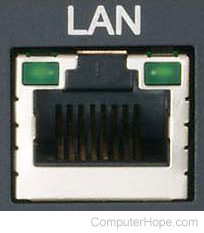Ethernet

Known initially as Alto Aloha Network, Ethernet is a widely used LAN (local area network) protocol created at Xerox PARC (Palo Alto Research Center) in 1973 by Robert Metcalfe and others (U.S. patent # 4,063,220). Being the first network to provide Carrier Sense Multiple Access / Collision Detection (CSMA/CD), Ethernet is a fast and reliable network solution still widely used today.
Ethernet adapter
An Ethernet adapter or Ethernet controller describes an Ethernet network card that connects a desktop computer to a network. If you are looking for network adapter drivers, you can find them on our network drivers page.
How to connect or plug in an Ethernet cable

Whether setting up your home network or connecting an Ethernet cable to your computer, the process is the same. Look for what appears to be a large telephone jack, similar to the image on the right. Once you've located it, push the cable connector into the port until you hear a click. If connected properly with a connection on the other end, a green LED (light-emitting diode) should indicate a signal is found.
To disconnect the Ethernet cable, press down on the top tab and pull back gently on the connector.
When disconnecting the cable, always pull by the connector, not the cable.
Ethernet standards
Below is a listing of different standards of Ethernet and additional information about each of them.
Ethernet II / DIX / 802.3
Ethernet II is a revised version of Ethernet rewritten by Digital Equipment Corp, Intel, and Xerox. Ethernet II, also known as DIX (Digital, Intel, and Xerox) and 802.3.
Fast Ethernet / 100BASE-T / 802.3u
Fast Ethernet (100BASE-T or 802.3u) is a communications protocol for sharing data at rates of 100 million bits per second instead of the standard 10 million bps. Fast Ethernet works over category 5 twisted-pair wiring.
There are two available 100BASE-T standards. The first standard, known as 100BASE-T, utilizes CSMA/CD. The second standard, known as 100VG-AnyLAN or 802.12, is similar to the other standard; however, it utilizes a different Ethernet frame to send its data.
100BASE-T is available with three different cable technologies
- 100BASE-T4 = Utilizes four pairs of telephone-grade twisted-pair wire and is used for networks that need a low-quality twisted-pair on a 100-Mbps Ethernet.
- 100BASE-TX = Developed by ANSI 100BASE-TX is also known as 100BASE-X, 100BASE-TX uses two wire data grade twisted-pair wire.
- 100BASE-FX = Developed by ANSI (American National Standards Institute), 100BASE-FX utilizes 2 stands of fiber cable.
Ethernet SNAP
Ethernet SNAP is short for Ethernet SubNetwork Access Protocol and is an Ethernet protocol that enables old and new protocols to be encapsulated in a type 1 LLC.
Gigabit Ethernet / 1000BASE-T / 802.3z / 802.ab
Gigabit Ethernet is also known as 1000BASE-T or 802.3z / 802.3ab. It is a later Ethernet technology that utilizes all four copper wires in a category 5 (Cat 5 & Cat 5e) cable capable of transferring 1 Gbps.
10 Gigabit Ethernet / 802.3ae
10 Gigabit Ethernet (10GE or 10 GbE or 10 GigE), also known as 802.3ae, is a standard published in 2002 and supports up to 10 Gb/s transmissions. 10 gigabit Ethernet defines only full duplex point-to-point links connected by network switches, unlike previous Ethernet standards. The half-duplex operation, CSMA/CD (carrier sense multiple access with collision detection), and hubs do not exist in 10 GbE.
1000BASE-CX
The 1000BASE-CX is a copper cable gigabit Ethernet standard that is no longer used. This standard was replaced by 1000BASE-T.
1000BASE-LX
The 1000BASE-LX is a fiber optic gigabit Ethernet standard that operates over single-mode fiber.
1000BASE-SX
The 1000BASE-SX is a fiber optic gigabit Ethernet standard that operates over multi-mode fiber with typical distances of up to 550 meters (1804 feet).
802 standards, Aloha, Cat5, CSMA/CD, Ethernet frame, Ethernet port, Hardware terms, IEEE, LAN, LLC, Network terms, POE, PPPoE, Protocol, RJ-45
